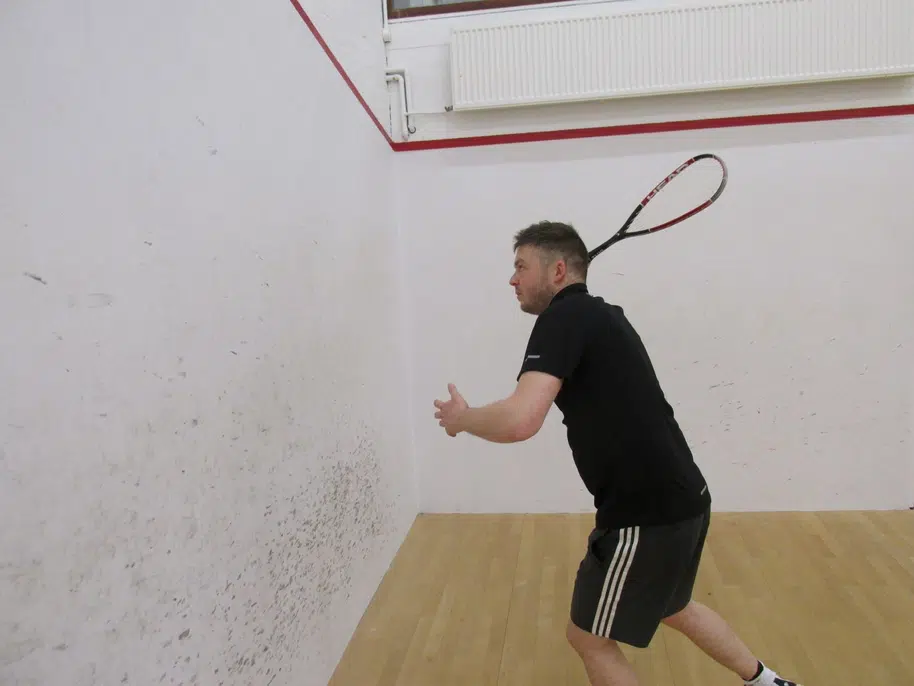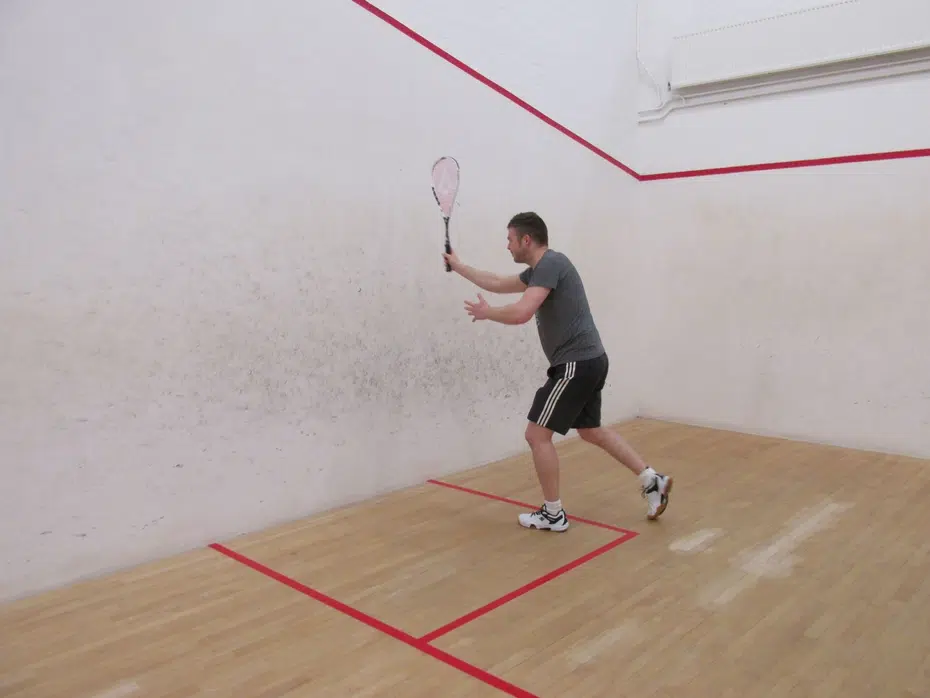There are many questions that beginners often share when they first set out to play squash. One of the most common of these is can you volley the ball in squash, or do you have to let it bounce first?
You can volley every shot in squash, as the ball does not have to hit the floor before you hit it. The return of serve can be volleyed back, and every subsequent shot in the rally can be volleyed.
Players tend to volley wherever possible to gain an advantage over their opponent in terms of court position and rushing them for time.
There are many times in squash when it is a good idea to volley the ball. Also, there are others when volleying is not practical.
In this post, I’ll look at:
- The rules on when you can volley in squash (it’s pretty simple!)
- The 6 most important times when you want to volley in squash
- The times when you shouldn’t volley
- How to play a squash volley
I’ll get stuck into all of these, and also a few tips on how to improve your volley and practice this crucial shot. (Here’s me playing a volley down the wall here…)

Volleying In Squash – The Rules
The rules of volleying in squash are simple and clear. You can volley every single shot, including the return.
The serve itself is a volley, as the ball must be thrown into the air and struck.
Volleying is one of the key skills in squash. There are times when it always makes sense, which I will list for you now:
5 Best Times To Volley
The simple thing is to say that you want to try to volley the ball whenever you are physically able, and the shot is not putting you at a disadvantage for whatever reason.
However, there are some times when volleying is almost always the best idea, and here is a list of some of the key times here:
1. Return Of Serve
The standard return of serve is a volley. If you can, it is a great idea to volley the ball before it hits the side wall.
The classic return of serve is the volley straight back down the line. You want to get the ball down this path, and then back toward the back-corner of the court.
Volleying the serve has many advantages including:
- You have a much shorter distance to get back to the T. If you leave the ball to hit the floor you will normally be hitting it somewhere near the back corner and have a much larger distance to travel back to the middle.
- You have less distance to hit towards the front wall. This means the shot should be more accurate.
- Your opponent has less time to get to the T themselves
- You have more options as to what shot you can play. A return of serve from the back can pretty much only be a straight drive. A volley could be a straight, cross-court, or you could also try some kind of drop. These are probably better played as variations, and keep most returns as straight volleys back down the line.
2. When Your Opponent Has Played A Loose Shot
Whenever the other player hits a shot that is not tight to the sidewall and that you can get to, it is wise to attempt a volley.
Volleys in general do the following:
- They rush your opponent for time
- Your opponent may not be back on the T and ready for the ball
- Your opponent may be wrong-footed or off-balance.
- They have no resting time in between shots
- It keeps your opponent running around more than you

3. When You Are In Front Of Your Opponent
If you are ever able to make contact with a volley when you are in front of your opponent, then this is a prime attacking opportunity. Many shots are now possible. These include:
- You can drive the ball to either back corner
- You can drop the ball into either front corner
- You can play an attacking boast off the side wall
- You can play a low kill, keeping the ball low and tight to either wall
4. When You Are Tired
If you feel you are tiring, maybe more than your opponent, then this is a great time to maximize any chance of volleying.
The beauty of volleying is that you don’t usually need to move very far from the T. It is normally a few yards away from the center of the court at the very most.
Being alert to any volleying opportunity will prevent you from having to put too many extra yards into your legs, whilst at the same time making your opponent run more than you.
5. When Your Opponent Is Tired
You may see that your opponent is tired and this is a great time to seize the initiative further by volleying even more.
This works well also if your opponent is much older than you, or if they are generally less mobile.
The goal is to keep them running as much as possible, whilst you stick around the front of the court, volleying the ball into the four corners.
You can win many points in succession quickly when your opponent is really exhausted, so these are key times to capitalize during a match.
When To Volley Table
| When To Volley | Why |
| Return of serve | If you are able to return the serve with a volley, then do so |
| Attacking a loose shot | Volleys can lead to a high number of won points |
| When in front of your opponent | They will then have to move around you to anything at the front court |
| When you are tired | You have to move less around the court |
| When your opponent is tired | You force your opponent to move faster to their next shot |
Times Not To Volley
Of course, there are also occasions when volleying is not practical (though it is legal). Usually, the majority of shots in a match are not volleys.
Some times when it is very difficult to volley include:
- When your opponent plays a shot quite tight to the side wall
- They play a shot with good ‘length’, i.e. the second bounce will be near the back of the court.
- The serve is hard and low into the side wall, or too high up for you to volley accurately
How To Play A Volley In Squash
There are several basics that you need to try to adopt when playing successful volleys.
These include:
- Try to stay side-on. This will help you direct the volley more accurately to the target area that you are aiming for on the wall.
- Keep your racket back. You have less time to play a volley than normal shots, so having good racket preparation is vital
- Show intent. You need to be aggressive in getting into volley-making position, otherwise, the ball will always be going past you.
- Try a variety of volleys, but if in doubt just go hard to the back of the court on the same side that you make contact.
Volley Practice Drills
The volley is a simple shot to practice using many simple drills. Some of these are solo drills, and others may require a partner.
Some of the most used include:
1. Simple Solo Volley Drill
Beginner Drill
This is the easiest and most used volley drill.
You quite simply stand a few yards away from the wall and volley the ball to yourself straight at the front wall. When the ball bounces back, take it on the volley, and repeat.
You can try on the forehand and the backhand sides.
The extension is to vary how far you stand from the wall. Simpler volleys will be played about 3-4 yards from the front wall, but you can also play some from the service line, or even some from the back of the court.
2. Moving Back And Forward Solo Volley Drill
This is similar to the first drill, but more for players wanting to take their volleying to the next level.
Start right next to the front wall and play some very short volleys to yourself. Then start slowly walking backward straight towards the back wall whilst continuing to play volleys.
The idea is to make your way all the way to the back wall without letting the ball hit the floor once.
When at the back wall, touch the wall with your racket, and make your way slowly back to the front wall, volleying as you go.
3. Figure Of 8s
This is one of the classic squash drills.
Stand on the T. Hit the ball high up on the front wall so that it hits the front wall about a foot from the edge. It will hit the front and side wall in quick succession and then loop back straight toward you (hopefully!).
Hit a volley to the other edge of the front wall, and get it to loop back to you. Repeat the process.
The easiest way to do this drill is to let it bounce first, but this is the harder version that is helping you to practice volleys.
4. Volley Drives With A Partner
Beginner Drill
There are many partners drills you can try, but here is just one good simple one. One player is roughly on the T, the other at the back on the forehand side.
The player at the back hits a forehand straight at the front wall. It will need to be at least a yard from the side wall, maybe more like two.
The player in the middle will step across and volley it straight back down the line. Repeat the process.
Next Steps
You are perfectly fine to volley every shot in squash. Volleying helps you maintain a good position in the center of the court, and can rush your opponent for time.
Many beginners find that the hardest volley shot they have to play is returning the serve. If this sounds like you, then check out this post I wrote about returning the serve with a volley in squash.
